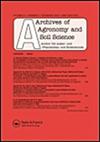Biochar increases maize yield by promoting root growth in the rainfed region
IF 2.3
4区 农林科学
Q1 AGRONOMY
引用次数: 20
Abstract
ABSTRACT Although biochar amendment could increase crop yield globally, it remains unclear how biochar improves grain yield. A two-year field experiment was conducted to investigate the role of plant roots in promoting crop growth under biochar amendment. The field experiment, started in 2015, was conducted in a rainfed region of North China. We hypothesized that biochar increases maize yield by promoting root growth. In the first year (2015), maize grain yield increased by 23.9% and 25.3% under biochar application rate of 20 and 40 t ha−1, respectively. Biochar increased the biomass of maize stalk and root and their potassium uptake significantly. The root morphology of maize also improved significantly following biochar amendment. Yet, the double increase in biochar application rate did not lead to any additional grain yield increase. The grain yield was positively correlated with the maize ear size, the soil organic carbon content, the biomass of maize stalk and root and their K uptake. In the second year (2016), however, biochar had no effect on the root morphology and the grain yield was not affected. Here we show that biochar increases maize yield by increasing maize ear size directly and by promoting root growth and nutrient uptake indirectly.在雨养地区,生物炭通过促进根系生长来提高玉米产量
摘要尽管生物炭改良剂可以在全球范围内提高作物产量,但目前尚不清楚生物炭是如何提高粮食产量的。进行了为期两年的田间试验,研究了植物根系在生物炭改良下促进作物生长的作用。这项田间试验始于2015年,在中国北方的一个多雨地区进行。我们假设生物炭通过促进根系生长来提高玉米产量。第一年(2015年),在生物炭施用量为20和40 t ha−1的条件下,玉米产量分别提高了23.9%和25.3%。生物炭显著提高了玉米茎和根的生物量和对钾的吸收。生物炭改良后玉米根系形态也有明显改善。然而,生物炭施用率的双重提高并没有导致任何额外的粮食产量增加。玉米产量与穗粒大小、土壤有机碳含量、玉米茎根生物量及其吸钾量呈正相关。然而,在第二年(2016年),生物炭对根系形态没有影响,粮食产量也没有受到影响。在这里,我们发现生物炭通过直接增加玉米穗大小和间接促进根系生长和养分吸收来提高玉米产量。
本文章由计算机程序翻译,如有差异,请以英文原文为准。
求助全文
约1分钟内获得全文
求助全文
来源期刊

Archives of Agronomy and Soil Science
AGRONOMY-SOIL SCIENCE
CiteScore
5.50
自引率
4.20%
发文量
107
期刊介绍:
rchives of Agronomy and Soil Science is a well-established journal that has been in publication for over fifty years. The Journal publishes papers over the entire range of agronomy and soil science. Manuscripts involved in developing and testing hypotheses to understand casual relationships in the following areas:
plant nutrition
fertilizers
manure
soil tillage
soil biotechnology and ecophysiology
amelioration
irrigation and drainage
plant production on arable and grass land
agroclimatology
landscape formation and environmental management in rural regions
management of natural and created wetland ecosystems
bio-geochemical processes
soil-plant-microbe interactions and rhizosphere processes
soil morphology, classification, monitoring, heterogeneity and scales
reuse of waste waters and biosolids of agri-industrial origin in soil are especially encouraged.
As well as original contributions, the Journal also publishes current reviews.
 求助内容:
求助内容: 应助结果提醒方式:
应助结果提醒方式:


